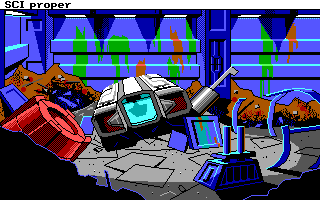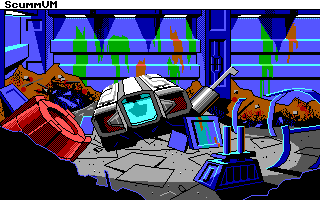Did Sierra ever call the various versions of SCI the same names we use? We being the fans, the tool creators, and the ScummVM developers?
It’s unlikely.
One thing to keep in mind is that the interpreter was in near-constant development by one team, while other teams made the games. Every so often the game developers would pull in the latest interpreter and system scripts from a network share. Another thing to keep in mind is that the version numbers are a little weird in places, and that the games themselves had their own version numbers on top of that, so for example you could have King’s Quest 4 version 1.000.106 running on SCI 0.000.274, but also KQ4 1.000.111 on the same interpreter, released five days later, and the later update with the changed graphics that was version 1.006.003 running on SCI 0.000.502.
The first generation of SCI, the one we call “SCI0”, had versions starting with “0.000”, such as the KQ4 example above. This covers every single 16-color, parser-based, English-only game, with the lone exception of the Police Quest 2 PC-98 release. That was version “x.yyy.zzz”, no joke. This generation can also be subdivided into two blocks, where versions up to 0.000.343 had green button controls instead of using whatever the window color was set to, covering the ’88 versions of KQ4 and the first version of LSL2, and the rest covered all the other games.
What we call SCI01 had versions starting with “S.old”. At least “x.yyy.zzz” has the placeholder excuse but whatever. SCI01 games were just like SCI0 on the surface, but had support for multiple languages (previously introduced in version x.yyy.zzz), and saw no more releases than ’88 SCI0 — six of ’em. So technically there’s nothing about that version string to inspire “SCI01”, besides perhaps KQ1 using “S.old.010″ 🤔
Next up was SCI1, which came in both EGA and VGA and usually had versions starting with “1.000″. There is one game, Quest for Glory 2, with five different interpreter versions that still had the text parser (and technically one Christmas card) before it was removed in favor of the icon bar. Some SCI1 games again have interpreters with very strange versions — it appears Eco Quest and Space Quest 4, among others, had some Special Needs™, given interpreter version “1.ECO.013” and “1.SQ4.057″. But on the whole you could still tell from the first character in the version that these were SCI1 interpreters.
SCI11 removed the multi-language support in favor of things like scaling sprites and the Message resource type. All SCI11 interpreters in the wild use versions starting with”1.001“, except for the ones used in Laura Bow 2 (“2.000.274”), Quest for Glory 3 (“L.rry.083”), and Freddy Pharkas (“l.cfs.081”), among a straggler or three.
Up to now these were 16-bit real-mode applications. SCI2, with versions starting “2.000” was a 32-bit protected mode application instead, with the ability to use much more memory and run in a SuperVGA video mode. No SCI2 interpreter found in the wild seems to stray from this version pattern, mostly because all SCI2 games use version 2.000.000. SCI21, in turn, runs on interpreter version 2.100.002, although there are technically three different sub-versions of 2.100.002. That’s not confusing at all. And finally, SCI3 was only seen in interpreter version 3.000.000.
I’m thinking after the switch to 32-bits, they must’ve stopped automatically bumping version numbers on build.
So what does Sierra call them, then? Well, sources say that Sierra called the 32-bit interpreters SCI32, and the source code archive that I based SCI11+ on was SCI16.ZIP. But none of the changelogs and such seem to refer to SCI0, SCI1, or whatever.
Happy slightly belated new year 🥂









 (and now you know why I looked into this)
(and now you know why I looked into this)



 in SCI Studio, a distinctive variation, and the bit under the pillar and to the left matched SCI Companion and ScummVM (past tense now),
in SCI Studio, a distinctive variation, and the bit under the pillar and to the left matched SCI Companion and ScummVM (past tense now),